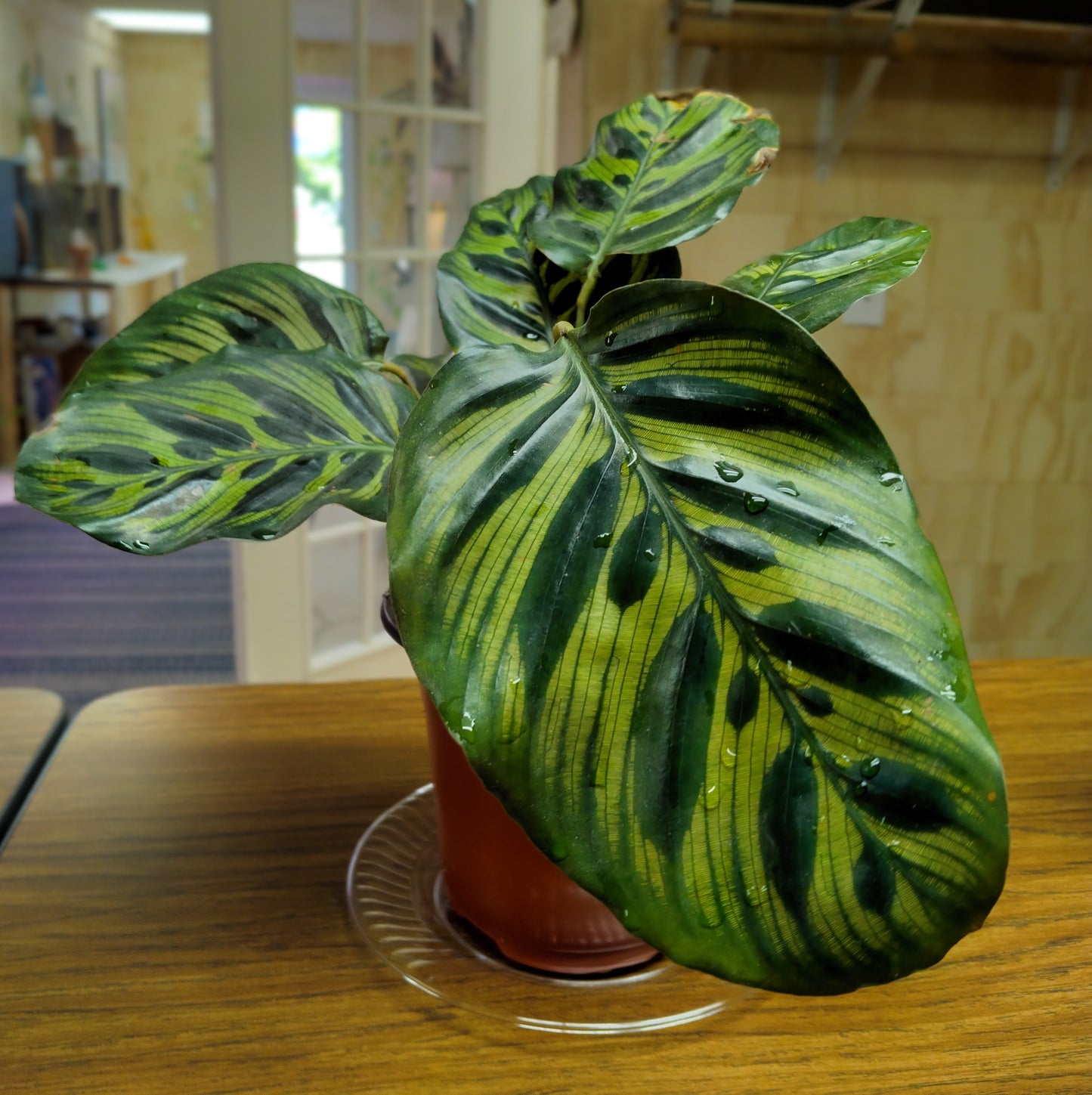The Happy Monstera Plant Co
Peacock plant
Peacock plant
Couldn't load pickup availability
🌿 Calathea makoyana (Peacock Plant) Overview
Botanical Name: Calathea makoyana
Common Names: Peacock Plant, Cathedral Windows, Prayer Plant (related group)
Family: Marantaceae
Origin: Native to eastern Brazil, thriving on the tropical forest floor under filtered light
Type: Evergreen perennial (grown indoors as a decorative foliage plant)
✨ Description
The Peacock Plant is named for its vividly patterned leaves, which resemble the eye spots of a peacock’s tail. Each leaf is a work of art:
-
Top surface: Pale green background with dark green feathered markings radiating from the midrib
-
Underside: Rich purple to maroon hue
-
Shape: Oval, slightly elongated leaves on slender, upright stems
-
Growth habit: Compact and bushy, forming a lush mound of 1–2 feet tall
The leaves fold upward at night, a characteristic behavior of Calatheas known as nyctinasty — similar to prayer plants (Maranta leuconeura).
☀️ Light Requirements
-
Prefers bright, indirect light — similar to the dappled sunlight of a rainforest floor.
-
Too much direct sunlight can fade or burn the leaf patterns.
-
Can tolerate lower light but will grow slower and may lose vibrancy.
💧 Watering
-
Keep soil consistently moist but never soggy.
-
Water when the top inch of soil feels slightly dry.
-
Use filtered, rain, or distilled water — Calatheas are sensitive to fluoride, chlorine, and mineral buildup.
-
Avoid letting the plant sit in standing water.
🌡️ Temperature & Humidity
-
Temperature: 65–80°F (18–27°C)
-
Avoid cold drafts and sudden temperature changes.
-
Humidity: High humidity (60–80%) is essential.
-
Use a humidifier, pebble tray, or group plants together.
-
Low humidity can cause leaf edges to brown or curl.
-
🌱 Soil & Potting
-
Prefers a light, well-draining mix that retains moisture but doesn’t stay soggy.
-
1 part potting soil
-
1 part perlite
-
1 part coco coir or peat moss
-
-
Repot every 1–2 years in spring to refresh soil and promote root health.
🌸 Fertilization
-
Feed every 4–6 weeks during spring and summer with a diluted balanced liquid fertilizer (¼ to ½ strength).
-
Avoid overfertilizing — it can scorch delicate roots and mar leaf edges.
🌿 Growth Habit
-
Compact and clumping.
-
Mature plants reach about 1.5–2 feet tall and wide.
-
Propagates by division rather than stem cuttings.
✂️ Pruning & Maintenance
-
Remove yellow or crispy leaves with clean shears to maintain appearance.
-
Wipe leaves gently to remove dust and allow for better photosynthesis.
-
Rotate periodically for even growth.
🌱 Propagation
-
Best propagated through root division during repotting:
-
Gently separate sections of the root ball, ensuring each has roots and leaves.
-
Replant in small pots with fresh mix and high humidity until established.
-
🪲 Common Issues
-
Brown leaf tips or edges: Low humidity, tap water chemicals, or overfertilization.
-
Yellow leaves: Overwatering or poor drainage.
-
Curling leaves: Underwatering or dry air.
-
Pests: Watch for spider mites, mealybugs, and fungus gnats in dry conditions.
📏 Mature Size
-
Height: 1–2 ft (30–60 cm)
-
Spread: 1–2 ft (30–60 cm)
-
Growth rate: Moderate, depending on humidity and light
💎 Fun Fact
The Peacock Plant’s leaf patterns are so vivid they almost appear hand-painted — no two leaves are exactly alike. Its nightly “prayer” motion makes it seem alive and responsive, making it a favorite among plant enthusiasts who enjoy interactive foliage.
Share

